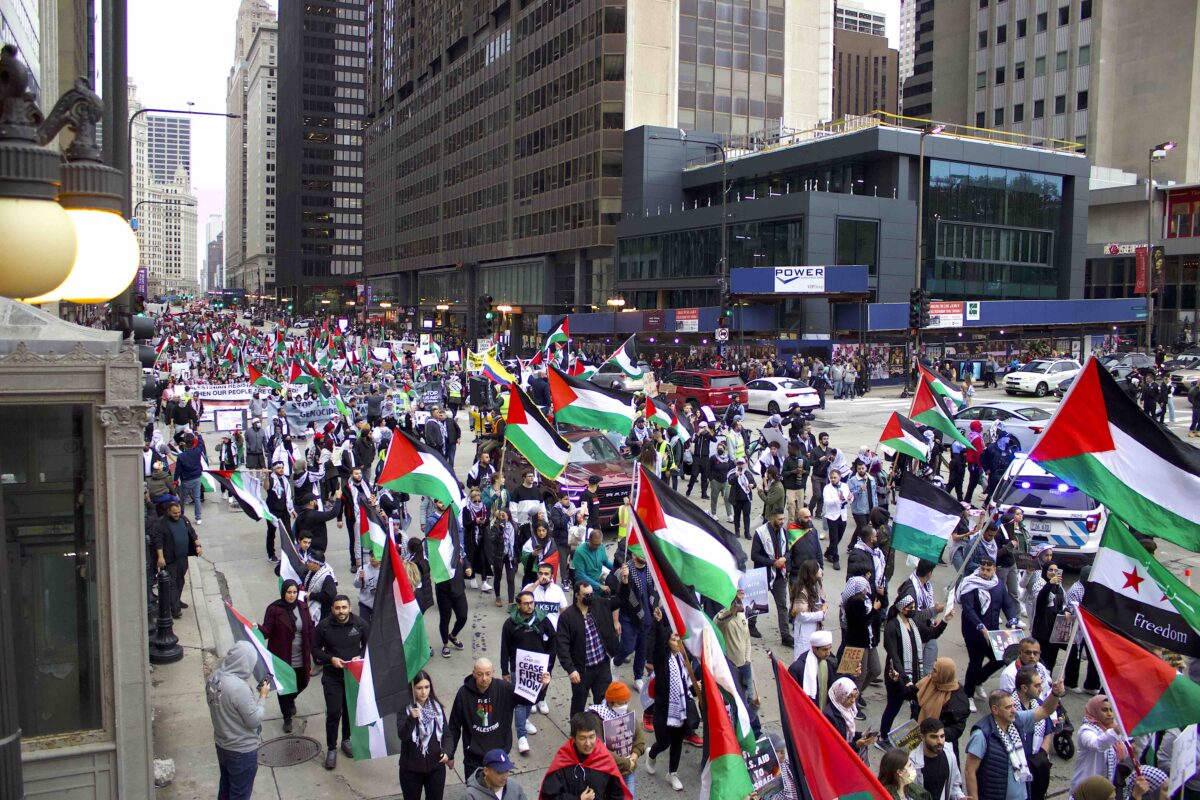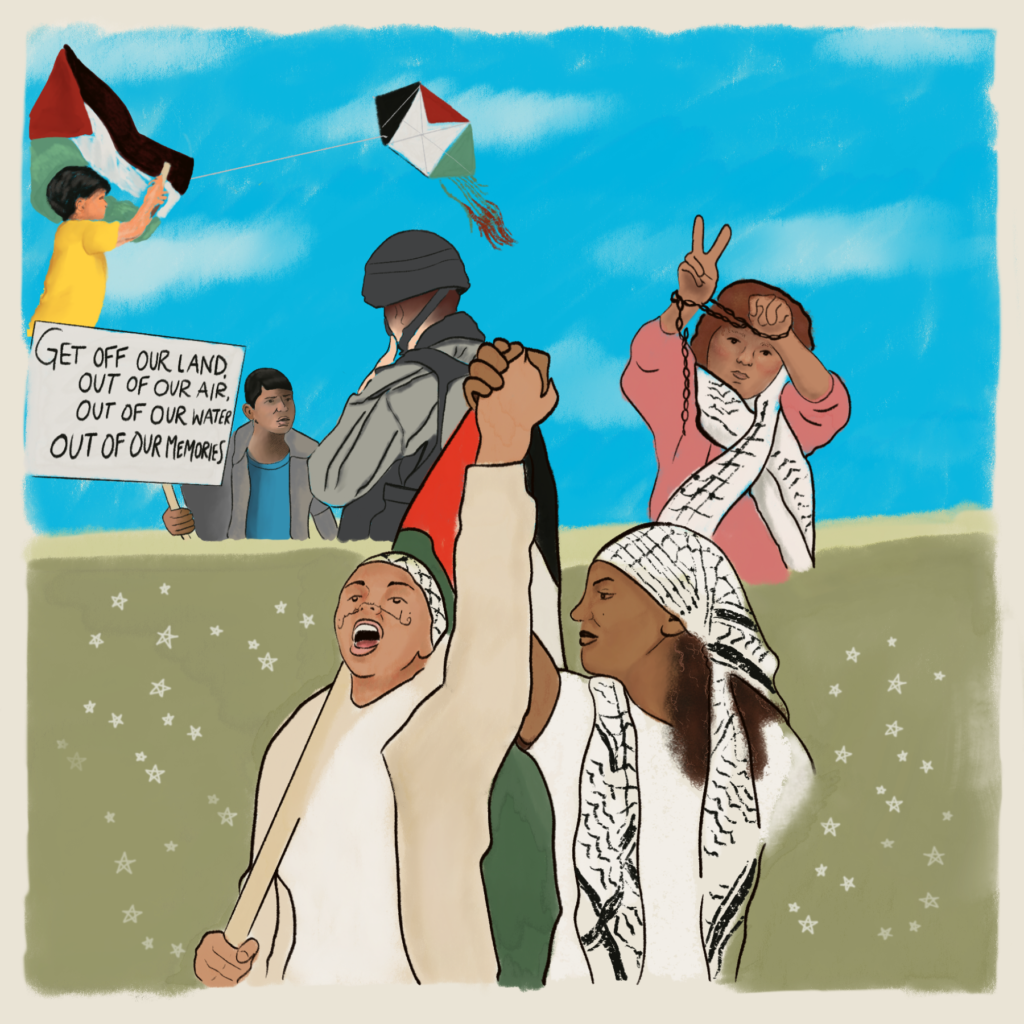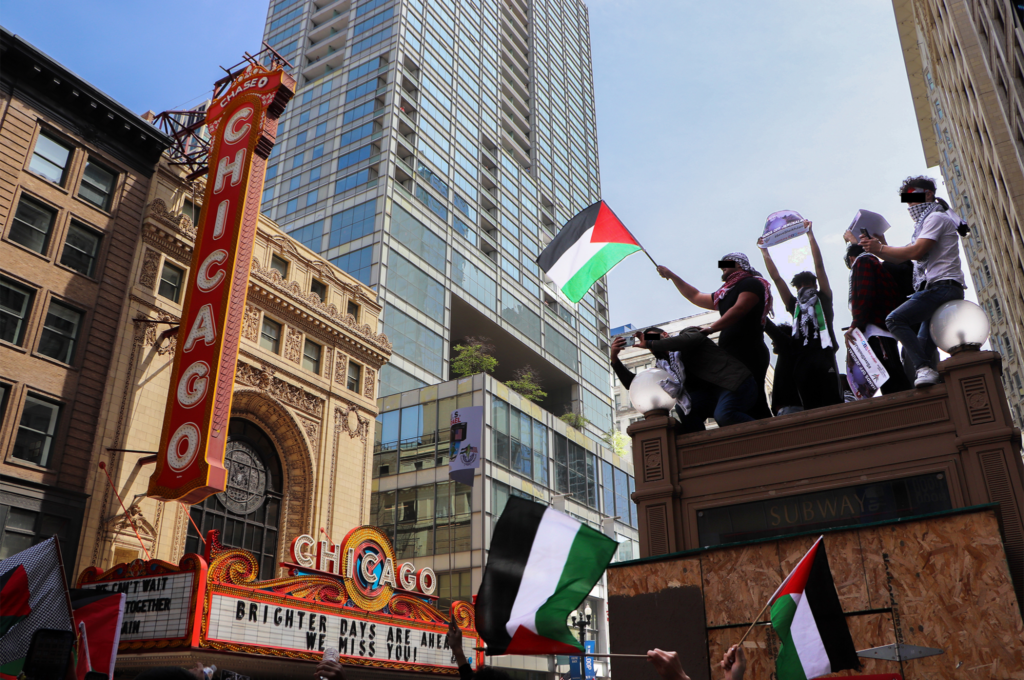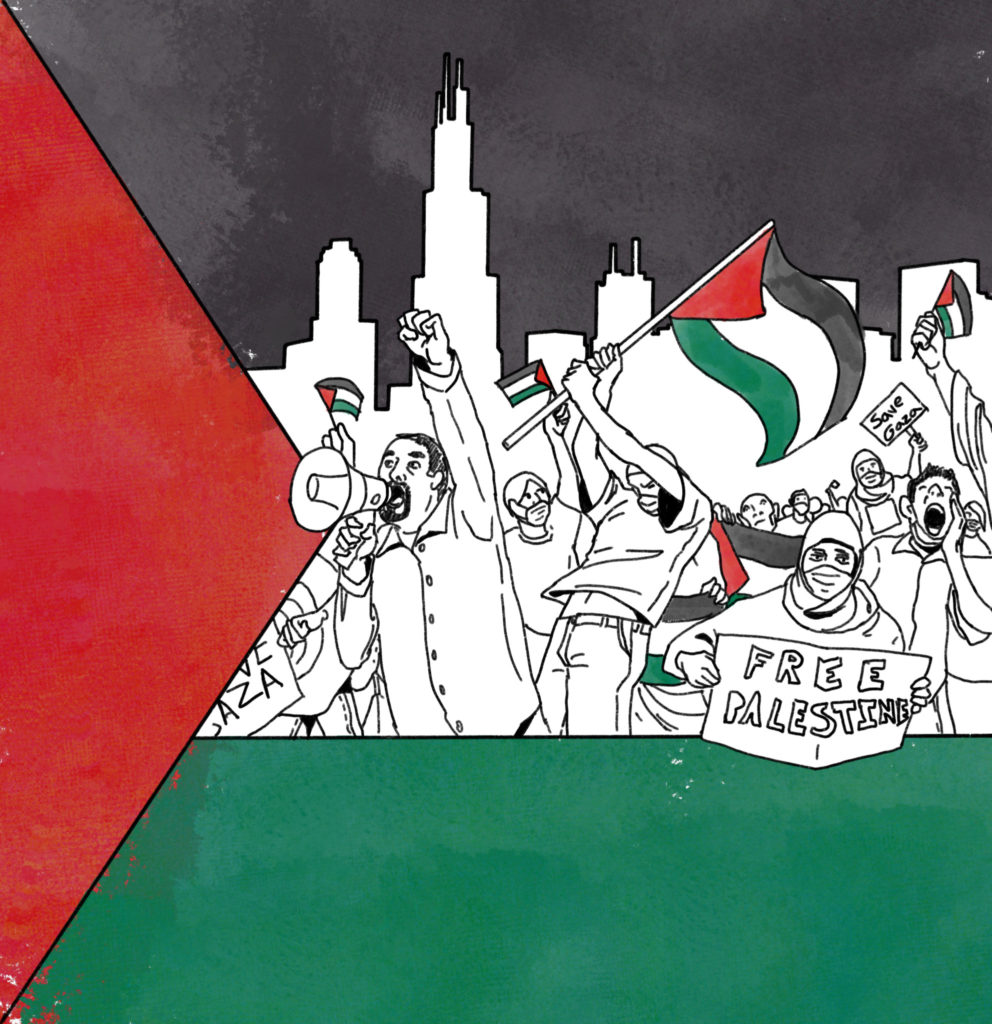For the past two Saturdays, Palestinian flags flew brightly against overcast skies as crowds amassed at the Congress Plaza to call for the immediate end to the ongoing siege by Israel on Gaza.
The rallies were multi-racial, consisting of folks who were Black, white, Asian, and Arab — namely, Palestinians, of which Chicago has one of the largest communities of in the U.S. — and multigenerational, including elders, babies, and families with young children.
Attendees came from all over Chicago on October 14, some arriving by bus from the Mosque Foundation in Bridgeview, the Islamic Community Center of Illinois (ICCI) in Elmwood Park, and the Orland Park Prayer Center in Orland Park. The rally was organized by the Chicago Coalition for Justice in Palestine (CSJP) to speak out against what organizers said are war crimes committed by Israel and the United States.
The following weekend, people returned to demonstrate again. L trains to the Loop were packed with demonstrators, and more drove and were bused in from across Chicagoland and as far as Detroit, Cleveland, and Milwaukee.
Since October 7, when Hamas, the governing body in the Gaza Strip, launched a surprise attack on Israel, the total count of those dead, injured, or displaced has continued to soar. The initial attack targeted southern and central Israel and killed at least 1,400 civilians, according to Israeli officials.
Israel has responded with a relentless aerial bombardment of Gaza, dropping at least 6,000 bombs, nearly matching the number of bombs dropped by the U.S. in Afghanistan in a year. The Hamas-controlled Gaza Health Ministry reported that by mid October more than 2,300 Palestinians have been killed and about 1 million were displaced.
Since October 9, Israel has completely cut off access to food, water, and electricity for Gaza, amounting to what protesters called a full-blown genocide.
“Access to basic needs [in Palestine] are completely controlled by the nation-state of Israel,” Diana Balitaan of Anakbayan Chicago told the crowd gathered on October 14. “Gaza does not have access to clean water and they barely have access to electricity, to fuel, and even going to work, they have to go through all these checkpoints. Those who are asking for peace, where are you right now?”
In addition to Anakbayan Chicago, Students for Justice in Palestine (SJP) and the U.S. Palestinian Community Network were among those who gathered on October 14 to express a united voice against Israel’s siege and U.S. imperialism at large. “All over the world, occupation, white supremacy, and imperialism is what needs to be condemned. We will not condemn people fighting for their freedom,” said one speaker who called the Chicago Teachers Union their political home. “When Nelson Mandela was asked to condemn the Palestinian resistance, he said absolutely not. The people in the United States who funded the apartheid regime in South Africa have no right to tell them to condemn the Palestinian resistance.”
The messages blared from demonstrators’ megaphones connected the dots between what is happening in Gaza and other movements against occupation and apartheid across history. Speakers also addressed the way the story of Gaza has been framed within mainstream media.
“Western media emphasizes this as a war between Gaza and Israel as if there were two equal sides,” said one protester. “This is a struggle between the colonized and the colonizer, the occupied and the occupier. Today we take back the narrative.”
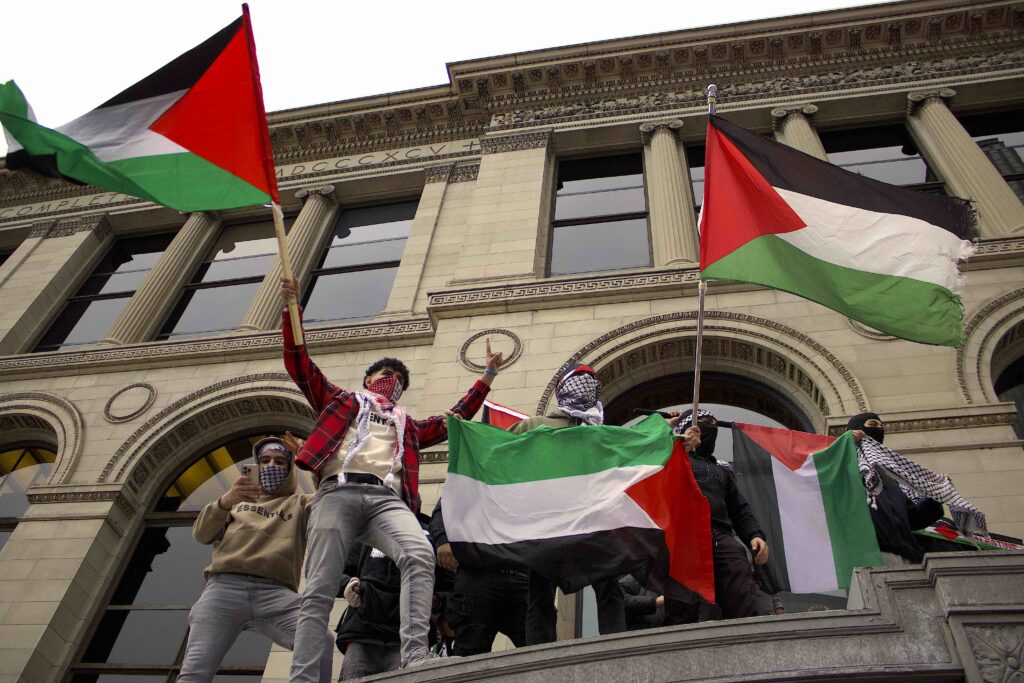
In 1948, 750,000 Palestinian people were displaced or expelled from their homes in what became known as the Nakba, or “catastrophe,” during the Arab-Israeli War that broke out after the United Nations completed the British Mandate of partitioning Palestinian land to create Israel. Another 300,000 Palestinian people were expelled from their homes in 1967 in the aftermath of the Six-Day War, during which Israeli forces also began occupying the Gaza Strip. In 1995, the signing of the Oslo Accords by representatives of Israel and the Palestinian Liberation Organization (PLO) established semi-autonomous Palestinian governance of Gaza and the West Bank, but Israeli settlements and military forces remained in Gaza until 2005. Hamas won the last elections held in Gaza in 2006.
Many of the protesters at both demonstrations criticized how Western media has portrayed—and obfuscated—not only that history but also more recent violence on the part of the IDF and far-right settlers in Gaza and the West Bank.
“There were multiple instances that we’ve seen happen in Gaza and Palestine in my lifetime that we knew about in the Arab community, but it was never reported. We didn’t see it on CNN. We didn’t see it on ABC. We didn’t see it on any major news outlet.” said Sanad Mahmoud, a Palestinian protester at the October 14 rally.
He said that reports only began appearing as usage of social media increased, bringing visibility to once unseen tragedies. With the increase of coverage, he has noticed the problematic ways in which Palestinians are framed. “The way they speak about murderers and the murdered. Fifty Israelis killed, 110 Palestinians died.” The relative power dynamics between the Israeli state and military and Palestinian militant organizations are “always framed as clashes between the two. Never for a fight for resistance or against our oppressors,” he said.
A 2021 study supported Mahmoud’s sentiment. Holly M. Jackson, a computer scientist who was then an undergraduate at MIT, used machine learning to analyze over 33,000 articles dating back to the First Intifada in 1987, found that the New York Times has historically employed framing that persisted anti-Palestinian sentiment.
Rifqa Falaneh, who took part in organizing the rallies this week and the public presence at the City Council special meeting on Friday, said the media has been biased in support of Israel and spread unconfirmed reports that were corrected too late to undo damage, with the end result being “to elicit sympathy for a settler colonial and apartheid regime while painting Palestinians as terrorists.”
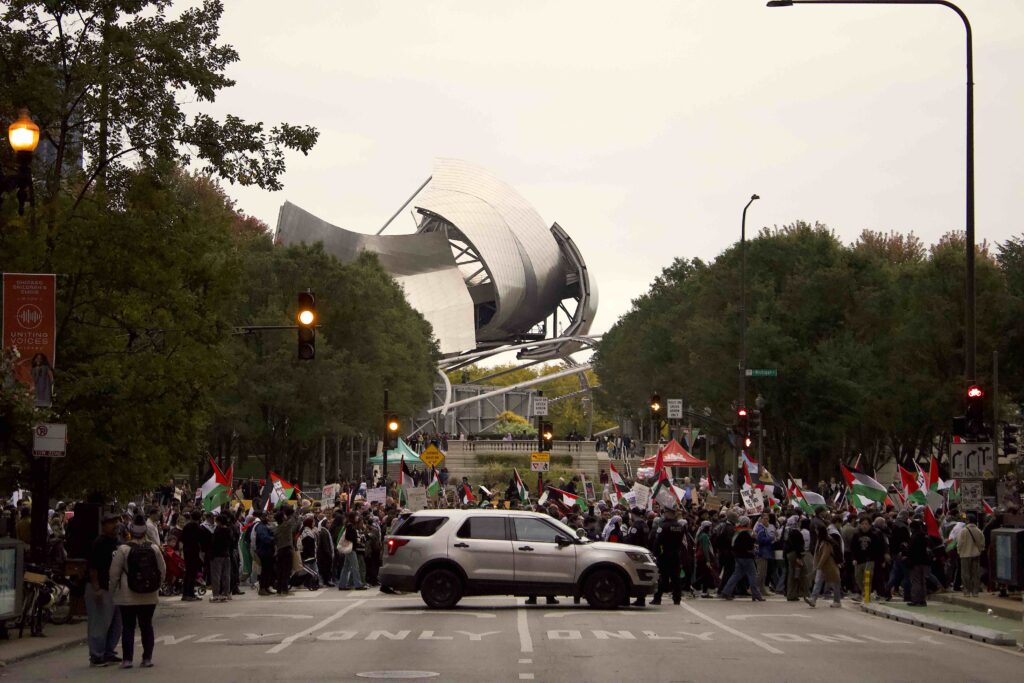
Earlier this month, the Chicago City Council held a special meeting to vote on a resolution proposed by Alderperson Debra Silverstein (50th Ward) standing in solidarity with Israel.
Public speakers at the October 13 meeting were divided in their emphatic support and opposition to the resolution (Mayor Johnson eventually cleared the audience after repeated outbursts), as were alderpersons who rose to speak about it ahead of the vote. The resolution ultimately passed, with 33rd Ward Alderperson Rossana Rodríguez Sánchez, who had previously attempted to convince Silverstein to add language acknowledging Palestinians’ humanity to it, casting the lone “no” vote.
Even though this was not the result Falaneh hoped for, she said people mobilized to “voice their opinion against the bill,” which she saw as a victory.
At the October 14 rally, speakers such as Frank Chapman of the National Alliance Against Racist and Political Repression, Destiny Harris of the Dissenters, and Tarek Khalil of the Coalition for Justice in Palestine, condemned the City Council’s decision to pass the resolution.
Aldersperson Rodríguez Sánchez addressed a crowd of thousands on October 21, as did Byron Sigcho-Lopez (25th Ward). Joining them were teachers, healthcare workers, and activists from Jewish Voice for Peace, the Chicago Faith Coalition on Middle East Policy, and others calling for an end to the occupation of Palestine.
Isabel, a twenty-one-year-old woman who attended that protest, told the Weekly she was there because “there’s an ethnic cleansing going on right now in [Gaza], and … we should do everything in our power to stop it.”
The week before, Falaneh tied U.S funding of war abroad to the disinvestment from communities here at home. “The U.S. sends $3.8 billion every year in military aid to Israel when they could be investing in solving homelessness, paying off student debt, or giving free healthcare to Americans,” she said.
Asked about how she stays hopeful, she said, “Although we are all devastated beyond belief, we are not privileged enough to pause our organizing and mourn. We cannot crumble while our people are dying. We must fight and make the call of freedom known now more than ever.”
On both days, after the speeches thousands of participants poured onto Michigan Ave., shouting at the top of their lungs, “From the river to the sea, Palestine will be free!” Children who looked to be as young as eight years old were shouting into microphones until their voices cracked. Some parents pushed blanket-swaddled babies in strollers, and toddlers swayed on the shoulders of others.
A thirty-two-year-old Black protester who grew up on the South Side and declined to give his name said he was at the October 21 march because he felt society needs to “wake up to the atrocities America perpetuates throughout the world.”
There’s no clearer example of that than Israel bombing Gaza, he said. “Our politicians stand with them and praise them as if they’re heroes, and they’re not.” He added that Biden should demand a ceasefire “immediately” and “actually pursue peace — not colonialism, not supremacy, true peace.”
On both days, not a single moment was surrendered to silence. “An action like today is a really healthy and cathartic way to release the pent-up frustration and energy collectively. It’s a really beautiful, healing moment for a lot of us in the diaspora who face the struggle of psychological torture that they inflicted upon us by separating us from our land,” said Mahmoud, adding that Palestinians who live here as American citizens do not have the right to return, referring to the inability to hold dual citizenship.
He wryly said that resistance is built into the Palestinian people’s very existence. “I am Palestinian through and through,” he said. “It sounds hard, but if anyone knows how to resist, it is Palestinians. We are never going to stop. We might get burnt out and tired, but I don’t see myself ever stopping to fight to free Palestine, even if I was the last person standing.”
He has found resistance in the Palestinian diaspora to be its own kind of home.
“I’ve been there. I’ve experienced the life. I’ve felt the ground,” he said. “I’ve seen the history and I know not only through my experiences, but through my parents’ experiences. I see Palestine in my mom’s face every single morning. I see it through her wrinkles, I see it through the hunch in her back. I see it in her age. I see Palestine in her and it’s not something I could ever stop fighting for.”
Kevin Hu is a multidisciplinary writer, tech worker, and a recent Chicago re-transplant. You can find more of their writing at www.kevinhu.dev.

